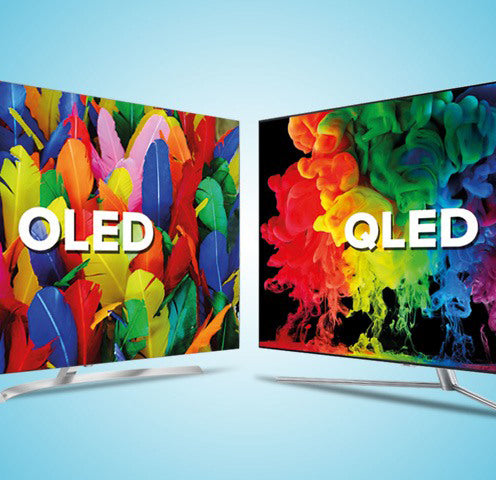By Alan C. Brawn CTS, ISF-C, DSCE, DSDE, DSNE, DCME | Originally published on PremierMounts.com
What's The Difference?
In flat panel displays, 4K continues to displace FHD displays, and video walls are continuing to grow. Interactive whiteboards and collaboration devices seem to be everywhere… but it is the banner of high dynamic range (HDR) waving over the burgeoning battle between OLED displays (like those from LG and Sony) and LCDs with quantum dot technology (championed by Samsung’s QLED) that seems to dominate our discussions of late.
It is more than marketing hype that is driving this issue. It is all about picture quality… or more correctly, significantly improved picture quality. Both types of flat panel are closely associated with HDR. The concept of dynamic range describes the extremes in the difference between white and black in an image, and how much detail can be shown in between those two absolutes… think of details in a shadow or highlight. Just expanding the range between bright and dark in a display is insufficient to improve a picture’s detail. It can ultimately only show so much information based on the signal it’s receiving. Current popular video formats, including broadcast television and Blu-Ray discs, are limited by standards built around the physical boundaries presented by older technologies. Black is set to only be so black, and white could only get so bright within the limitations of display technology. While display technologies are improving, many current video formats can’t take advantage of it.
Only so much information is presented in the signal, and a display capable of reaching beyond those limits still must stretch and work with the information present. HDR removes the limitations presented by older video signals and provides information about brightness across a much wider range. Besides the wider range of values, HDR video contains the ability to provide more data to describe more steps in between the extremes. This means that very bright objects and very dark objects on the same screen can be shown (assuming the display chosen supports it). Shadows show nuanced details, and bright spots show fine details in the highlights, not just blank white fields. This is all where QLED and OLED literally come into the picture.
SAMSUNG QLED
Quantum dot technology (like Samsung’s QLED, which we will focus on) is an advancement on traditional LCD technology. QLED utilizes a new (more ideal) light source for an LCD. QLED can produce a very wide color gamut, higher brightness, and increased dynamic range… all while being built using existing LCD display factories.
The quantum dots are nano-sized crystal particles of special phosphor, tuned to emit specific wavelengths of light by varying their size. The quantum dots are embedded into a film, that can replace the diffusion film traditionally used with LCD backlights. That light then travels through several other layers inside the display, including a liquid crystal (LCD) layer, to create the picture. The light from the LED source is transmitted through the layers to the screen’s surface, which is why it is called “transmissive.” The white LEDs in a quantum dot-based LCD are replaced with UV blue LEDs. The blue light combines with red and green light produced from the quantum dots to create the illumination used by the LCD. Because QLED is transmissive, the LCD must “block” light, which can slightly reduce the maximum black level. They are also currently thicker than their competition, due to the layers of glass needed. These two trade-offs come with the benefit of using phosphor to produce a wider color gamut than other technologies, and QLED backlights are able to produce much higher levels of luminance (up to 2500 nits peak).
LG OLED
Organic Light Emitting Diode or OLED (From LG and Sony, primarily for large displays) produces some of the best black levels and outstanding colorimetry. OLED was originally developed for smaller sized displays… but it’s properties positioned it quickly as an alternative to the venerable LCD, which continues now against QLED displays. OLED started out in the consumer realm, but we are seeing more commercial models being introduced as well as a few unique variations on the theme.
OLED is a light-emitting technology, made by placing a series of organic thin films between two conductors. When electrical current is applied, a light is created through a phenomenon called electroluminescence (which is the same principle used in LED technology). OLEDs are called emissive displays since they do not require a backlight, they produce their own light. OLED displays can be thinner than nearly any other display technology and use less energy to run than QLED. In an OLED display, the pixels themselves are the elements producing the light, and so when they need to be black they can turn off completely, rather than relying on a backlight to turn off on their behalf. This provides a black level superior to any other display technology currently available. However, being emissive, OLED displays don’t have the ability to produce extreme levels of brightness, being limited to 5-700nits.
If we take a fair look at both technologies and compare them… both take images to the next level of quality and more closely approximate what the human eye can see. There are advantages on both sides, something very apparent at CSE 2018 as these creative solutions continue to take hold. OLED is thinner and lighter, more energy efficient, and produces the best black level. QLED leads in brightness, lifespan, is not prone to burn in, expanded color space, and is less expensive. Each has their place… but be aware that this is only the beginning of future developments. Expect to see the QLED vs. OLED competition ramp up significantly over the next few months. Who benefits? The viewer does, with image quality that surpasses anything we’ve seen yet!





